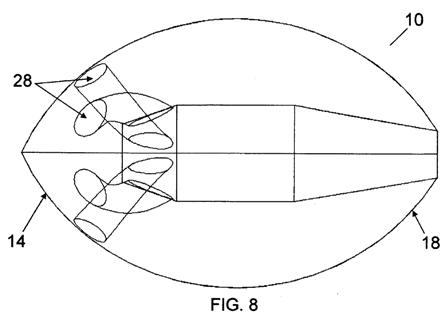An Invention That My Beloved Buckeye Football Team Could Use
Over the summer I came across an interesting patent that was worth saving until football season, and it serves as a good example that bizarre sports patents aren’t limited to the field of golf.


The patent describes the invention as:
Disclosed is a self-propelled football with an internally ducted fan and electric motor. An exemplary embodiment has an oblate spheroidal body. The body has a front section, a center section, a back section, and a longitudinal axis. The ducted fan is located within the body substantially within the center section and substantially along the longitudinal axis. The electric motor is located within the body and mechanically coupled to the ducted fan. At least one electrical power source is located within the body and electrically coupled to the electric motor. At least one air-inlet is located within the front section of the body in airflow communication with the ducted fan. At least one air-outlet is located within the back section of the body in airflow communication with the ducted fan. A means for automatic activation and deactivation of the electrical motor is located within the body.
The patent goes on to explain that the field of self-propelled footballs is not new. Amazing!
One attempt to improve travel distance included a propeller enhanced football. This football has fins extending from the rear of the football where a propeller is externally located. The propeller is soft, so as not to injure a player. This is necessitated because the propeller is exposed and not internally located within the football. The football doesn’t behave like a normal football, as it has fins extending out the back and an external propeller. The football is suited only for throwing. It is not intended to be played in a football game where handoffs, lateral passes, pitches and kicks occur. Furthermore, since the propeller is exposed and soft, the power produced by the football is weak at best and not much self-propulsion truly occurs.
Some have developed an engine-spiraled, stabilized football through an internal combustion engine. This football has the internal combustion engine located within the football that drives a propeller housed within a gyroscopic propeller ring. The internal combustion engine requires a fuel. Therefore, players must put into the football a combustible fuel, like gasoline. Combustible fuels and footballs don’t go well with each other. Gasoline is a dangerous chemical that is not suited for a children’s toy. Furthermore, an internal combustion engine produces heat which could present a fire hazard. The internal combustion engine could also burn a player when the football is handled. Compounding these dangers are the exhaust gases produced by the internal combustion engine. Playing with a football that emits toxic fumes is highly undesirable. Also, there is no control technology devised in the football that allows the football to easily self activate and deactivate when thrown. Therefore the engine must be started and left running while in use. Also, an external starter is needed to start the motor before the engine will operate. For all of the aforementioned reasons and others not discussed, the internal combustion engine should not be placed within a football intended for use by people, especially children.
SUMMARY OF THE INVENTION
A self-propelled football is disclosed. An exemplary embodiment of the self-propelled football has an oblate spheroidal body. The body has a front section, a center section, a back section, and a longitudinal axis. A ducted fan is located within the body substantially along the center section and substantially along the longitudinal axis. An electric motor is located within the body and is mechanically coupled to the ducted fan. At least one electrical power source is located within the body and electrically coupled to the electric motor. At least one air-inlet is located within the front section of the body in airflow communication with the ducted fan. At least one air-outlet is disposed along the back section of the body in airflow communication with the ducted fan. A means for automatic activation and deactivation of the electrical motor by detecting an in-flight condition and a not-in-flight condition is located within the body.
Could there be a market for such a product (assuming it actually worked)?
Dave Dawsey – A Sports Equipment Patent Attorney

